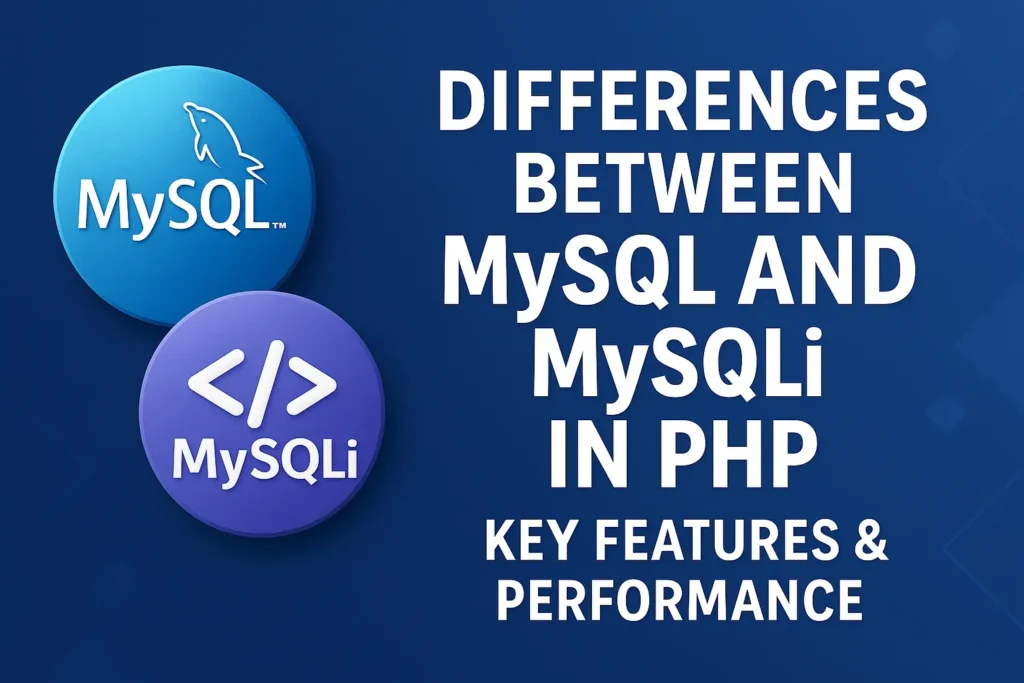While both serve the purpose of connecting PHP applications to MySQL databases, there are significant differences and improvements in MySQLi that make it a better choice for most applications. This article will explore the key differences between MySQL and MySQLi, highlighting the improvements that MySQLi brings to the table.
Key Differences Between MySQL and MySQLi
1. Object-Oriented vs. Procedural Interface
MySQL:
The original MySQL extension provides only a procedural interface. This means that all functions are called in a procedural manner, with no support for object-oriented programming.
MySQLi:
MySQLi supports both procedural and object-oriented programming styles. This dual interface offers developers more flexibility and allows for cleaner, more modular code when using the object-oriented approach.
Example of Procedural Style in MySQL:
$connection = mysql_connect('localhost', 'user', 'password');
if (!$connection) {
die('Could not connect: ' . mysql_error());
}
mysql_select_db('database');
$result = mysql_query('SELECT * FROM users');
while ($row = mysql_fetch_assoc($result)) {
echo $row['name'];
}
mysql_close($connection);
Example of Object-Oriented Style in MySQLi:
$mysqli = new mysqli('localhost', 'user', 'password', 'database');
if ($mysqli->connect_error) {
die('Connection failed: ' . $mysqli->connect_error);
}
$result = $mysqli->query('SELECT * FROM users');
while ($row = $result->fetch_assoc()) {
echo $row['name'];
}
$mysqli->close();
2. Support for Prepared Statements
MySQL:
The original MySQL extension does not support prepared statements, which can lead to security vulnerabilities, such as SQL injection, if not handled properly.
MySQLi:
MySQLi fully supports prepared statements, which provide a more secure way to execute SQL queries. Prepared statements separate SQL logic from data, reducing the risk of SQL injection attacks.
Example of Prepared Statements in MySQLi:
$mysqli = new mysqli('localhost', 'user', 'password', 'database');
if ($mysqli->connect_error) {
die('Connection failed: ' . $mysqli->connect_error);
}
$stmt = $mysqli->prepare('SELECT * FROM users WHERE email = ?');
$email = 'user@example.com';
$stmt->bind_param('s', $email);
$stmt->execute();
$result = $stmt->get_result();
while ($row = $result->fetch_assoc()) {
echo $row['name'];
}
$stmt->close();
$mysqli->close();
3. Multiple Statements
MySQL:
The MySQL extension does not support multiple statements, which means you cannot execute more than one SQL query in a single function call.
MySQLi:
MySQLi supports multiple statements, allowing you to execute several SQL queries in one function call. This can improve performance by reducing the number of round trips between the PHP script and the MySQL server.
Example of Multiple Statements in MySQLi:
$mysqli = new mysqli('localhost', 'user', 'password', 'database');
if ($mysqli->connect_error) {
die('Connection failed: ' . $mysqli->connect_error);
}
$sql = 'INSERT INTO users (name, email) VALUES ("John Doe", "john@example.com");';
$sql .= 'INSERT INTO users (name, email) VALUES ("Jane Doe", "jane@example.com");';
if ($mysqli->multi_query($sql)) {
do {
if ($result = $mysqli->store_result()) {
while ($row = $result->fetch_assoc()) {
echo $row['name'];
}
$result->free();
}
} while ($mysqli->next_result());
} else {
echo 'Error: ' . $mysqli->error;
}
$mysqli->close();
4. Enhanced Debugging and Error Handling
MySQL:
Error handling in the MySQL extension is limited, and debugging can be cumbersome. Errors are often returned as strings, making it harder to programmatically handle different types of errors.
MySQLi:
MySQLi provides improved error handling and debugging capabilities. Errors are represented by error codes and messages, allowing for more precise error handling in your code.
Example of Enhanced Error Handling in MySQLi:
$mysqli = new mysqli('localhost', 'user', 'password', 'database');
if ($mysqli->connect_error) {
die('Connect Error (' . $mysqli->connect_errno . ') ' . $mysqli->connect_error);
}
if (!$mysqli->query('INSERT INTO non_existing_table (name) VALUES ("Test")')) {
echo 'Error: ' . $mysqli->error;
}
$mysqli->close();
5. Support for Transactions
MySQL:
The MySQL extension has limited support for transactions. Transaction management must be handled manually, which can be error-prone and cumbersome.
MySQLi:
MySQLi provides full support for transactions, allowing for atomic operations. You can begin, commit, and rollback transactions, ensuring data integrity and consistency.
Example of Transactions in MySQLi:
$mysqli = new mysqli('localhost', 'user', 'password', 'database');
if ($mysqli->connect_error) {
die('Connection failed: ' . $mysqli->connect_error);
}
$mysqli->autocommit(FALSE);
try {
$mysqli->query('INSERT INTO accounts (user_id, balance) VALUES (1, 1000)');
$mysqli->query('UPDATE accounts SET balance = balance - 100 WHERE user_id = 1');
$mysqli->query('UPDATE accounts SET balance = balance + 100 WHERE user_id = 2');
$mysqli->commit();
echo 'Transaction completed successfully';
} catch (Exception $e) {
$mysqli->rollback();
echo 'Transaction failed: ' . $e->getMessage();
}
$mysqli->close();
6. Support for Stored Procedures
MySQL:
The MySQL extension does not natively support stored procedures, which limits the ability to use advanced database features directly through PHP.
MySQLi:
MySQLi supports stored procedures, enabling you to leverage advanced database functionality and encapsulate complex SQL logic within the database.
Example of Calling Stored Procedures in MySQLi:
$mysqli = new mysqli('localhost', 'user', 'password', 'database');
if ($mysqli->connect_error) {
die('Connection failed: ' . $mysqli->connect_error);
}
$stmt = $mysqli->prepare('CALL GetUserByEmail(?)');
$email = 'user@example.com';
$stmt->bind_param('s', $email);
$stmt->execute();
$result = $stmt->get_result();
while ($row = $result->fetch_assoc()) {
echo $row['name'];
}
$stmt->close();
$mysqli->close();
7. Parameter Binding
MySQL:
The MySQL extension does not support parameter binding, making it more difficult to write secure and maintainable SQL queries.
MySQLi:
MySQLi supports parameter binding, which helps prevent SQL injection and makes your SQL queries cleaner and easier to read.
Example of Parameter Binding in MySQLi:
$mysqli = new mysqli('localhost', 'user', 'password', 'database');
if ($mysqli->connect_error) {
die('Connection failed: ' . $mysqli->connect_error);
}
$stmt = $mysqli->prepare('INSERT INTO users (name, email) VALUES (?, ?)');
$name = 'John Doe';
$email = 'john@example.com';
$stmt->bind_param('ss', $name, $email);
$stmt->execute();
$stmt->close();
$mysqli->close();
Conclusion
While both the MySQL and MySQLi extensions allow you to interact with MySQL databases from PHP, MySQLi offers a range of improvements that make it a superior choice for modern web development. The key differences between MySQL and MySQLi include support for both object-oriented and procedural programming, prepared statements, multiple statements, enhanced debugging and error handling, transactions, stored procedures, and parameter binding.
These features not only improve the security and performance of your applications but also make your code more maintainable and easier to read. By leveraging MySQLi, developers can take full advantage of the latest MySQL database functionalities and ensure their applications are robust, secure, and efficient.






